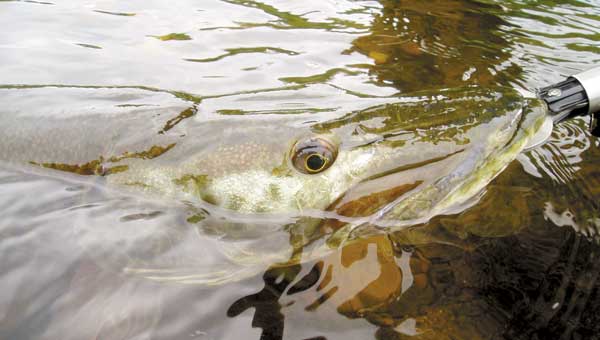
Marauding muskies attack anglers’ lures at the New River like Confederate raiders ambusing Union Troops.
What was that?” said the other angler in the canoe.It was understandable he should ask the question. Moments earlier, a savage strike had snapped a 10-pound-test line (which now lay limp on the surface), neatly severing a buzzbait from the monofilament.
A second before the impact, an extended, boiling wake had indicated what kind of piscatorial cruise missile had locked in on its target. The line and lure had as much chance to survive the collision as the angler holding the rod had to corral the creature that caused it.
“Muskie,” I said.
That outing at the New River is typical of what North Carolina sportsmen may experience at the part of the stream that courses from the Tar Heel state north through southwestern Virginia.
Joe Williams, a fisheries biologist for the Virginia Department of Game and Inland Fisheries, manages the river’s muskie fishery.
Although no genetic studies have been conducted, the biologist said the consensus is that muskellunge aren’t native to the New River watershed.
Nevertheless, stocking efforts between Fields Dam and Baywood have been successful.
“Annually, the VDGIF releases about 1,000 4- to 8-inch fish into this section,” Williams said. “Although we haven’t witnessed any reproduction, we suspect some is taking place, although not enough to sustain the fishery.”
The biologist said a 2007 surveying expedition revealed a number of 2- to 3-year-old fish in the 28- to 29-inch range, evidence that growth rates are quite satisfactory in the New. From this and other surveys, Williams wanted to make one point extremely clear.
“It’s a myth that our stocked muskies are eating large numbers of smallmouths,” he said. “The VDGIF has pumped the stomachs of some 200 fish, and we only found six smallmouths inside. Muskies simply don’t have a significant impact on a smallmouth fishery.
“What we found is that up to two years of age, muskies eat mostly shiners and minnows. At age three, more sunfish family members start showing up in their stomachs. But as muskies grow older, they consume mostly suckers and carp.
“Now when a fisherman is reeling in a smallmouth and sees a muskie strike it, all that muskie is doing is reacting to what it considers a fish in distress that’s about to become an easy meal. A lot of people don’t believe this data, but that is what we have found.”
Williams rated the river section between Fields Dam and Baywood as “fair to good” for muskellunge. Of course, he said, muskies aren’t gamefish that anglers can catch on demand. Even in what are considered excellent waters, these “water wolves” often demand many hours of fruitless casting, punctuated by some of the most intense, trophy fish action an angler can experience.
During the summer months at this section of the New, Williams suggested anglers target pools at least 4- to 5-feet deep, located near riffles, rapids or aerated water of some kind, such as where a spring or a cool-water tributary enters the main flow.
Aquatic vegetation such as water willow, elodea and curly-leaf pondweed also draw this member of the pike family. Muskellunge often lurk in vegetation, especially during the middle of a sultry summer day.
Williams said he may change the stocking regimen of muskies at the New.
“I am considering stocking fewer but larger fish,” he said. “The VDGIF may stock, say, only 100 fish, but they would be between 12- and 15-inches long. This might become a classic case of less is more, as these larger fish could have a far higher rate of survival.”
Summer lures
Forest Pressnell, a former Winston-Salem resident now living at Max Meadows, Va., guides for Greasy Creek Outfitters. He said throughout warm weather periods, success for muskie anglers starts with oversize artificial lures.
“Once the water warms, the bigger, louder lures are great,” Pressnell said. “A muskie will hit a bait to defend its territory, even if it isn’t hungry.
“(That causes the) teeth marks you see on other fish, such as bass and sunfish (in the New River). A muskie doesn’t intend to eat everything it hits, so the loud lures, especially the topwater ones, will bring a fish from as far away as 60 feet.
“In low, clear summertime water, I like the big jerkbaits, in-line spinners and single-blade spinnerbaits. When the water is dingy, I’ll use the big topwaters and double-bladed spinnerbaits. At night, I go strictly with topwaters.”
Pressnell said given the rapids that pocket the New, he doesn’t recommend anyone navigate the waterway at night, unless they’re with a guide or a local person extremely familiar with the stream. It’s also important to understand how the guide defines big lures, which he considers artificials, in the 1- to 6-ounce class and from 6- to 12-inches long.
They consist of 1- to 4-ounce single- and double-bladed in-line spinners with or without trailers, 4-ounce topwater poppers with bucktail trebles, 1- to 2-ounce single- and double-bladed spinnerbaits with 4-inch Case grub trailers with stinger hooks, 6- to 10-inch soft-plastic creature lures and 6-ounce jointed jerkbaits.
Regarding colors, the guide said it’s prudent to stay with natural green, gray, brown and black-and-white in clear water, then go with the brighter, gaudier hues in stained or dingy liquid. Black, orange, purple or a combination of those colors are effective at night.
John Spicer and Gracen Lucas operate S&L Outdoors at Sparta. Given the close proximity of the store to the New River in Alleghany County, they’re able to keep close tabs on the fishery.
“The reports we are getting are that the muskies are running from 24 to 48 inches,” Spicer said.
Lucas said from customer reports, the most-effective lures include 9-inch Rapala CountDown Saltwater Magnums, 7-inch Rapala Originals, 5 ¼-inch Jointed Rapalas, 9-inch Suick Muskie Killers and ¾-ounce Mepps Musky Killers.
Interestingly, during early summer, Marty Shaffner, who operates Tri-State Angler Guide Service, uses lures more associated with river smallmouths, as he opts for 5-inch tubes and ½-ounce jig and pigs in black-and-red or black-and-blue. After the water warms, the Wilkes County resident turns to the same large jerkbaits and bucktail spinners Lucas recommends.
But Shaffner also has found deep-running crankbaits can dredge up muskies lurking in shaded pools and ¾-ounce buzzbaits are good for overcast days when the fish are shallow.
Hooksets are crucial
Pressnell recommended anglers fish with their drags locked and set the hook as hard as they can three times in a row, then back off the drag.
“Muskies have incredibly tough, bony mouths, and I have even lost a muskie or two halfway through a battle after I made three massive hook sets right after the strike,” Pressnell tutored. “As you wear the fish down, and he’s coming closer to the boat, you may think you have him whipped. But this is the time to back the drag down even more as he’s not finished by any means, and the looser drag will make the situation much more forgiving in close quarters.
“When fishing from a raft, if a client hooks a muskie, we always go to shore and get the angler and myself out of the boat — muskie teeth can ruin your day — to finish and land the fish with some sort of lip tool.
“Generally, fishermen don’t carry a big enough landing net unless they’re specifically targeting muskie. And please don’t grab the lip or gill plate with your hand or it will be time for a lot of stitches.”
Boat-side tactics
Pressnell said muskie are notorious for following a lure to the boat.
“You’ll see this big ‘V’ wake forming in the water, just keep retrieving and don’t stop,” he said. “When a muskie hits a topwater (lure), let the fish have the lure, like you would for all other surface fishing, before you set the hook.
“Whether a muskie misses the lure or you haven’t seen a fish, before you finish the retrieve at the boat, do the figure 8 a couple of times with the rod tip in the water.
“I estimate two-thirds of my muskies were caught after I made the figure 8 at the boat.”
Where to go
Four possible float trips exist at the New between the Old Dominion and the Tar Heel states, as the river crosses back and forth between Grayson and Alleghany counties, respectively.
Because of a reciprocal license agreement between the two states, licenses from either one are valid while fishing at the New River.
The four muskie fishing trips include from the confluence of the North and South Forks of the New to Mouth of Wilson (5 miles), Mouth of Wilson to Bridle Creek (6 miles), Bridle Creek to Independence (10 miles), and Independence to Baywood (12 miles).
Of the quartet, Marty Shaffner has a favorite.
“Of the border floats, the Bridle Creek trip is the best section to fish for muskies,” he said. “Virginia stocks a lot of muskies in this stretch, and it has the best muskie habitat and holds the best muskie populations — at least in my opinion.
“The Bridle Creek trip is known for its slower, deeper holes with deep ledges and submerged trees, as well as laydowns along the bank. Also, this section has a lot of shallow, rocky flats with adjacent weed beds. When those flats and beds are next to deep pools, you can sometimes find muskies that have moved shallow and are out hunting.”
John Spicer offers a different junket.
“I would say we’re receiving the most reports from the Independence to Baywood section, which has a lot of deep pools,” he said.
At 12 miles in length, the Independence excursion is the longest of the four floats but only features one rapid of any note, a lone Class I that occasionally will rank as a Class II during high water.
Muskie seekers more interested in hunting for fish than running rapids likely will favor the Independence trip. Conversely, the Bridle Creek getaway, although it features a number of deep pools and slow stretches, also flaunts the Class III Penitentiary Falls, three Class II and numerous Class I rapids. The Confluence trip only contains Class I rapids, and the Mouth of Wilson one features a sole Class II and several Class I stretches.
New’s old tricks
Despite the difficulty of angling for the upper New’s muskies, Marty Shaffner and Forest Pressnell remain major fans of this gamefish.
“Some days are muskie days and some aren’t,” Shaffner said. “Muskies are moody fish. Some days they seem non-existent; some days they follow and won’t take; some days they eat. Stay persistent, fish proven lures in good habitat and eventually you’ll have success.”
“The muskie is a cherished prize for any angler,” Pressnell said. “There are many people that kill these fish because they think the muskie is eating all their bass and sunfish. The plain truth is the muskie is a lazy feeder, preferring white suckers and slow-moving targets. A water system with a healthy population of all species is beneficial to all species that inhabit it.
“Flathead catfish are the nemesis of smallmouth bass, not muskie.
“Please practice catch and release with this magnificent creature; and if you want a mount, get the length, girth, and some photos and go fiberglass, which only costs a little more than standard skin mounts, lasts forever, and spares this giant to battle another day.”

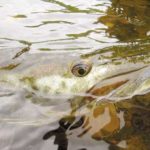
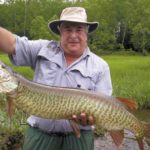
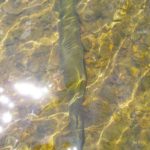


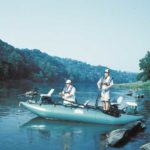

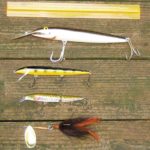


Be the first to comment